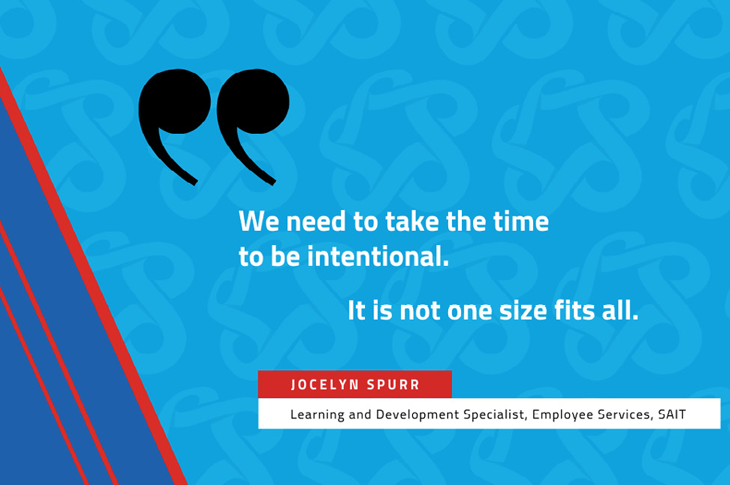Employees as lifelong learners

Like a flash flood, the COVID pandemic transformed the landscape of the workforce almost overnight, carving new routes out of necessity. Spotlighting priorities. Recalibrating approach and expectations.
SAIT’s Corporate Training team recently assembled a panel of local learning and development leaders for an inspired conversation about the status and future of corporate learning. With loads of great fodder, it’s worth watching the full webinar, but here are a few of the key takeaways.
The Great Resignation is not inevitable
Today’s employees are re-evaluating their individual priorities, and organizations that want to retain these people need to do the same. Panelist Shane Anderson, Director Global Talent and Organizational Development, Stantec, sees the phenomenon as a great reprioritization, and the natural response one of reciprocity.
“Find out what matters to people,” suggests Anderson. “What do they base their priorities on?” If an employee says, ‘It means more to me that I go and grow than that I stay and produce,’ then support that person in their growth so they stay.”
Organizations that can find a way to prioritize development over production are bound to attract, garner and grow great people. Organizations with great people are primed for success.
Learning is largely unscripted
About 70% of learning happens during the regular course of day-to-day work. It’s driven by need and/or curiosity.
“We’ve [all] developed capabilities in our organizations in the last two years in ways we never could have imagined,” says Amber Reimer, Regional Market Lead, Deloitte “... built resiliency, speed to market, agile decision making.
The kinds of capabilities that would have been in the top five growth goals for most organizations back in 2019. “Not that we asked for it, but we sure got it.”
Instead of trying to control what people learn, teach learning agility. Create development plans that serve the direction of the organization. Alignment with organizational need is paramount.
“We can have all this open training ... on human skills development or soft skills,” says Kathy Osterland, Director of Learning and Development, Wajax. “But there has to be some value [in it] to the company.”
Paula Blackmore-White, Manager People Development, Benevity comments, “There is an illusion of control when it comes to learning and development, at best we probably control maybe ten percent of what our people learn. Our people are learning everything, all the time, in all manner of ways.”
Foster a corporate learning culture that aligns, promotes, recognizes and rewards learning and on-the-job mentorship. Build and rely on the momentum of the culture to carry learnings through and forward.
Technology should be purposeful and inclusive
COVID forced us to branch out of the classroom and into online delivery models. Virtual livestreams extended access across space and time. The immediate sense of urgency expedited an appetite for all things tech. Senior leadership stepped it up with prompt buy-in. Algorithms are already directing next steps.
“We can come up with whatever we want, but it has to be the right fit with the right tools for the right audience, and it has to be inclusive,” says Nikki Mountford, Acting Senior Manager of Organizational Effectiveness and Learning Services, Cenovus.
Though intended to advance our human capabilities, if we’re not mindful, tech can hinder individuals with less experience or other challenges. It can make learning exclusive.
If it’s not the right fit for purpose it can distract us from our end goal. A shiny new implement doesn’t change the fundamental learnings.
“The only thing that changes about the fundamentals,” says Paula Blackmore-White, Manager People and Development, Benevity, “is your attention to them.”
Extend the finish line
We invest in learning and development to build capacity and advance our organizational goals. Learning outcomes that are effectively tied to business outcomes show up as transformational change. The return on investment (ROI) can be measured accordingly.
Under normal circumstances, change is a process — not a pivot. ROI can take time to show up.
A two-day course that ends after the second day doesn’t contribute to the learning ecosystem. Inaction always comes at a cost.
People need time to test, apply and share their learnings with their team.
“Extending that finish line two, three, six, nine months out from when you’ve taken that course should have a significant impact,” says Mountford.
Reward people beyond the initial investment in them. Make bringing back their learnings part of their development plan. Give them credit for investing back.
Register for SAIT’s Corporate Training Leading Beyond Any Title webinar series and contact our outstanding corporate learning specialists to support your company’s learning and development strategies.
Follow SAIT Corporate Training on LinkedIn and subscribe to our newsletter to stay up to date on training resources and talent development tailored for industry leaders.
Learning for Life
We prepare students for successful careers and lives.
SAIT'S
2020-2025
Strategic plan

Oki, Âba wathtech, Danit'ada, Tawnshi, Hello.
SAIT is located on the traditional territories of the Niitsitapi (Blackfoot) and the people of Treaty 7 which includes the Siksika, the Piikani, the Kainai, the Tsuut’ina and the Îyârhe Nakoda of Bearspaw, Chiniki and Goodstoney.
We are situated in an area the Blackfoot tribes traditionally called Moh’kinsstis, where the Bow River meets the Elbow River. We now call it the city of Calgary, which is also home to the Métis Nation of Alberta.